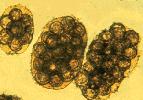Cyclophyllidea Life-Cycle
Overview
Cyclophyllidea cestodes have an indirect life cycle involving one or more intermediate hosts before developing into adult form in the definitive host. Eggs must be ingested by an intermediate host species, once ingested the gastric and intestinal secretions breakdown the thick shell and activate the 6-hooked oncosphere. The oncosphere uses its hooks to tear through the gastrointestinal mucosa to reach the blood or lymph system. In invertebrate hosts the oncosphere will enter directly into the body cavity from the gastrointestinal tract. The oncosphere then travels to its predeliction site, loses its hooks and develops into the larval stage known as a metacestode. This can be one of a number of forms dependent on the species of cestode. When the metacestode is ingested by the final host, the scolex attaches to the gastrointestinal mucosa, the remainder of the structure is digested, and a chain of proglottids (segments) begins to grow from the base of the scolex. Eggs are produced within the terminal proglottid of the chain which is shed into the feaces of the host once the production is complete.
Infection of the final-host involves at least three epidemiological relationships:
1) predator-prey, e.g. cat eating infected mouse
2) accidental, e.g. horse eating infected pasture mites
3) irritation, e.g. infected flea on animal → exaggerated grooming of animal → swallowed
Metacestodes
There are six types of metacestode (in increasing order of complexity:
Cysticercus
This is a simple metacestode consisting of a fluid filled bladder containing a single inverted scolex.
Cysticercoid
This is a simple metacestode that is only found in invertebrates. It is small, pinhead sized, and instead of a bladder has a potential space containing a single scolex that is not inverted.
Strobilocercus
This metacestode is only formed by the cat tapeform Taenia taeniaeformis and is similar to a cysticercus however the single scolex is attached to the containing bladder by a chain of segments.
Coenurus
Similar in form to the cysticercus, however the coenurus contains multiple inverted scolices.
Hydatid cyst
This metacestode consists of a fluid filled bladder that can grow to a considerable size. It is lined by a germinal epithelium that buds off to form brood capsules. These brood capsules contain multiple inverted scolices and are termed hydatid sand. The response from the host is to wall off the cyst with fibrous tissue around the germinal layer.
Alveolar cyst
Similar to the hydatid cyst however the alveolar cyst forms daughter cysts, these bud off from the internal and external surface of the germinal layer. These buds enable the cyst to invade into the tissue of the organ rather like a tumor.
| Cyclophyllidea Life-Cycle Learning Resources | |
|---|---|
To reach the Vetstream content, please select |
Canis, Felis, Lapis or Equis |
 Test your knowledge using flashcard type questions |
Cestode Flashcards |
 Search for recent publications via CAB Abstract (CABI log in required) |
Cestode life cycle publications |
| This article has been peer reviewed but is awaiting expert review. If you would like to help with this, please see more information about expert reviewing. |
Webinars
Failed to load RSS feed from https://www.thewebinarvet.com/infection-control-and-biosecurity/webinars/feed: Error parsing XML for RSS
